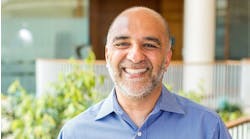Q&A: Marc Rabner, M.D., M.P.H., CRISP Shared Services’ First Chief Medical Officer
CRISP Shared Services (CSS), the nonprofit arm of Maryland’s health information exchange that provides services to other HIEs across the nation, has named Marc Rabner, M.D., M.P.H., as its first-ever chief medical officer.
In addition to Maryland’s CRISP, CSS has grown to support CRISP DC, West Virginia Health Information Network, Virginia Health Information, Alaska’s healtheConnect and Connecticut’s Connie.
Rabner is a practicing pediatrician at Children’s National Medical Center in Washington, D.C. Previously, he was a pediatric hospitalist at Children’s Hospital of Philadelphia. He has served as a clinical adviser to the organization for the past three years. He has been a driver in CSS’ work across affiliates and local governments to advance coordinated, cross-agency social determinants of health data projects for vulnerable populations, including CRISP Maryland’s Medication Redetermination effort.
In a recent interview with Healthcare Innovation, Rabner explained why CRISP Shared Services decided to hire a chief medical officer, and why he was interested in the position.
HCI: Did you have some background in health IT or interoperability issues that led you to a connection to CRISP?
Rabner: I took kind of a weird path, I think, for people in the HIE space. I came at it from more of a public health lens. Even before medical school, I spent time in Ecuador, and then during medical school I did community health outreach in South Philly working at a free clinic for Latino populations. I saw how the things that happened outside of the walls of the hospital and clinic were impacting health outcomes. Then I did public health and preventive medicine training at Johns Hopkins. Recognizing that the IT systems and EHRs were so valuable from a data standpoint, that was where I fell into the health information exchange world and I just love the impact that it can have, not only as a health information exchange itself, but also how it can empower the care teams with data to actually have an impact on patients.
HCI: You started out as a clinical adviser to CRISP for a few years before taking the CMO position. Can you describe an initiative that you worked on in that advisory capacity?
Rabner: I helped lead our social determinants of health work for Maryland. We were trying to figure out how to improve interoperability for both social needs identification and social needs intervention data. We were seeing that the community health world was replicating some of the mistakes that we made with EHR world early on, where we had lots of data silos and not a lot of interoperability, and fragmented care. We were seeing social determinants of health vendor platforms creating these silos as well, and community-based organizations having similar silos for different reasons. But those data really weren't flowing, so we worked to create tools that helped share that data at the point of care, so that other members of the care team could know what social needs patients had and what interventions they had.
HCI: So in Maryland primary care settings, have you started to see improvement in terms of that data getting to the right place in the process?
Rabner: There is always room to grow. There are a lot of barriers on social determinants of health data. From a collection standpoint, the incentives really haven't been in place to incentivize clinicians and clinical care teams to screen for social needs at scale. That's changing with some regulatory requirements that are coming down, so we're seeing that pick up, but it's been a slow start because of some of those barriers. I'm hopeful that these changes will move us in the right direction.
HCI: How did the need for this role of CMO at CRISP Shared Services develop? What are some of the responsibilities you're taking on?
Rabner: I think there was an opportunity to provide clinical expertise and guidance to our partner agencies, where there were questions or projects that required clinical knowledge and understanding of workflows. CSS manages the IT infrastructure for its affiliates, and the engineering teams often need that clinical input to design solutions that work for people and that are actually valuable. They were often getting blocked by questions that needed clinical input to answer. There's a real practical value to having that clinical expertise available to be able to answer some of those questions.
HCI: As you help the CSS engineering teams, do you also have to develop rapport with the people in other states to make sure that the decisions that you're making align with what they want?
Rabner: Yes. There are different types of decisions, ranging from does it make sense to show this column heading versus does this use case makes sense for this population? I think where local control is extremely valuable is for those decisions about what matters to their population, as well as data governance and where data should go, to whom, and for what reason.
HCI: I have been interviewing other HIE leaders about the concept of a health data utility. I know that the State of Maryland passed a law last year which established CRISP as the state health data utility and set out rights and responsibilities for CRISP and all the different stakeholders to participate in it. But are there use cases or governance issues that are different for a health data utility than for what most people think of as a traditional HIE?
Rabner: I think the traditional model of the HIE is clinical stakeholders sending data to each other. This expands that concept beyond the walls of the typical healthcare delivery sites and payers to include public health and other nonclinical stakeholders.
For instance, we have a use case around asthma. There's a priority in Maryland for decreased emergency department utilization among children with asthma, and better controlling their asthma so they're not showing up in the emergency department. Oftentimes, I would see a patient come to me with two or three visits to either the ED or inpatient setting in a year. I can treat them as a hospitalist and send them home, but they're still going home to their house that has mold or cockroaches that cause their asthma exacerbation. So what can we do to better connect the clinical side to the public health side, which can actually intervene with that family to help them improve their environmental control of their asthma? In Maryland, we can identify children who present to the emergency department with asthma and automatically send that information to a Medicaid-supported program. that's run by the local health departments so that the local health departments can reach out to those families and ask them if they're interested in the environmental controls that they offer. They could actually go into the house and provide HEPA filters, get rid of vermin, and do all these environmental controls to help prevent that patient from going to the hospital. What's really great about the HIE is we're able to do that in near real time so that we can ask about their interest in those services when it's relevant. What we see is that a lot in patients for the week or two after their ED visit or hospitalization are very interested in not letting it happen again. But then as time goes on, their interest in enrolling for these kinds of services wanes, so being able to provide services when it's most relevant to the family and patient is very valuable.
HCI: Do you have any other projects that you're excited about working on in the next couple of months with the CSS affiliates?
Rabner: The Medicaid redetermination work is really important. You're really risking losing coverage and care for a lot of patients. And a lot of the most vulnerable patients are on Medicaid to begin with. We're doing a really interesting use case with Medicaid in Maryland. They basically send us the date that the patient is being up for redetermination — the date they have to submit all their paperwork by and then we match that to the provider panel and send that to the clinic or the hospital or FQHC to make sure that they're aware that the patient that they're going to see in a week, still has insurance when they show up for their appointment. The provider groups and clinical sites in general have found it extremely valuable to make sure that they're providing that continuity of care and that those patients aren't losing coverage because they're doing the outreach to the patients to make sure that they're continuing to be covered.
!['I just love the impact that [an HIE] can have, not only as a health information exchange itself, but also how it can empower the care teams with data to actually have an impact on patients,' says Marc Rabner, M.D. 'I just love the impact that [an HIE] can have, not only as a health information exchange itself, but also how it can empower the care teams with data to actually have an impact on patients,' says Marc Rabner, M.D.](https://img.hcinnovationgroup.com/files/base/ebm/hci/image/2023/06/MarcRabner_headshot.647f84f807ecc.png?auto=format,compress&fit=max&q=45&w=250&width=250)

